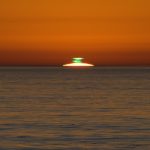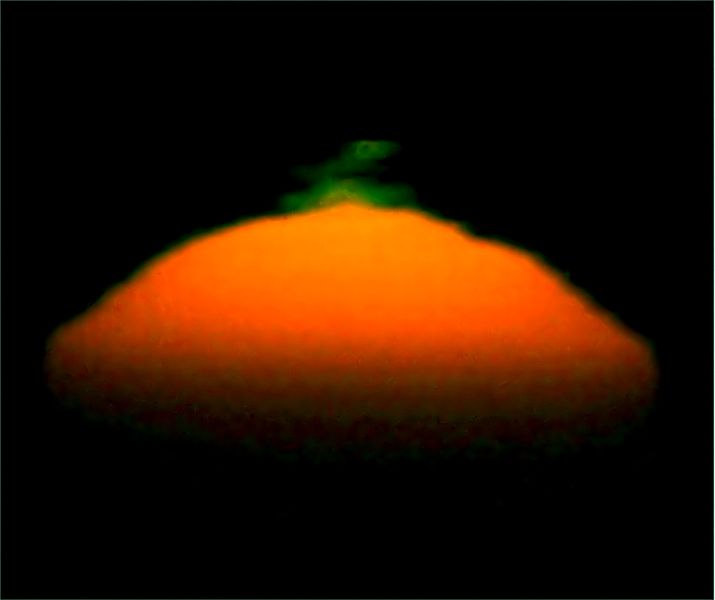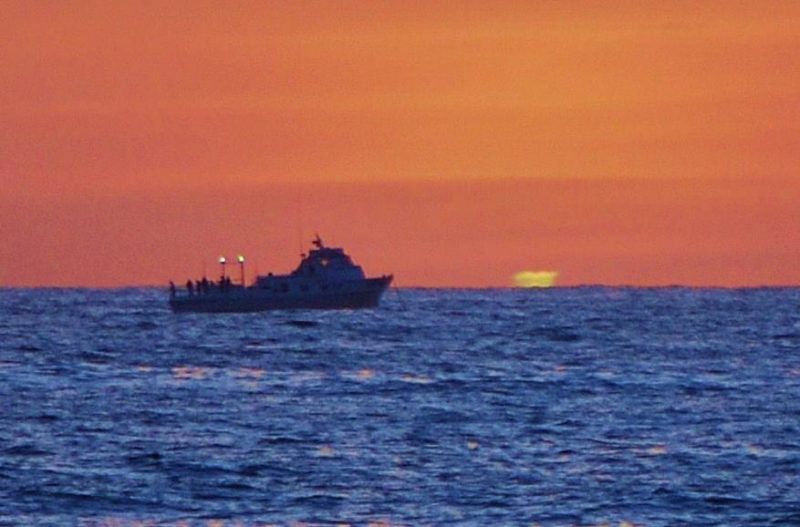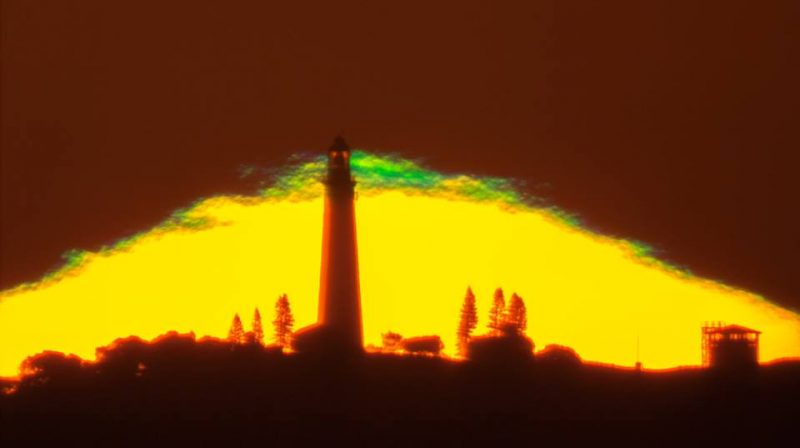
The green flash image at the top of this post was taken by Chris Mannerino, from San Diego, California, USA, on December 13, 2017.
It’s not hard to see a green flash with the eye alone, when sky conditions are right, and when you’re looking toward a very clear and very distant horizon. That’s why those who live near an ocean tend to report green flashes most often. A sea horizon is the best place to see them.
The video below, posted to EarthSky by Vladek in 2016, is an excellent example of the experience of seeing a green flash:
EarthSky 2021 lunar calendars are in stock! Order now. Going fast!
Most people see green flashes just at sunset, at the last moment before the sun disappears below the horizon. Be careful and don’t look too soon. If you do look too soon, the light of the sunset will dazzle (or damage) your eyes, and you’ll miss your green flash chance that day. But if you wait – looking away until just the thinnest rim of the sun appears above the horizon – that day’s green flash could be yours.
Of course, the green flash can be seen before sunrise, too, although it’s harder at that time of day to know precisely when to look.

Mock mirage and green flash seen from San Francisco in 2006. Image via Brocken Inaglory/ Wikimedia Commons.
There are many different types of green flash. Some describe a streak or ray of the color green … like a green flame shooting up from the sunrise or sunset horizon.
The most common green flash, though – the one most people describe – is a flash of the color green seen when the sun is nearly entirely below the horizon.
Again … you need a distant horizon to see any of these phenomena, and you need a distinct edge to the horizon. That’s why these green flashes, streaks, and rays are most often seen over the ocean. But you can see them over land, too, if your horizon is far enough away. Pollution or haze on the horizon will hide this instantaneous flash of the color green.
If you’re interested in green flashes, Andrew Young’s green flash page is great. He also has a page of links to pictures of green flashes taken by people from around the globe.
And, of course, Les Cowley at the great website Atmospheric Optics devotes many pages to the green flash phenomenon. Notice the menu bar at the left side of the page; it’ll let you explore many different types of green flashes.
Bottom line: The green flash is legendary, and some people have told us they thought it was a myth, like a unicorn or a pot of gold at the end of a rainbow. But green flashes are very real. You need a distant and exceedingly clear horizon to see them at the last moment before the sun disappears below the horizon at sunset.
Enjoying EarthSky so far? Sign up for our free daily newsletter today!
Can you see a green flash? More tips, plus more pictures
from EarthSky https://ift.tt/3i7qHQB

The green flash image at the top of this post was taken by Chris Mannerino, from San Diego, California, USA, on December 13, 2017.
It’s not hard to see a green flash with the eye alone, when sky conditions are right, and when you’re looking toward a very clear and very distant horizon. That’s why those who live near an ocean tend to report green flashes most often. A sea horizon is the best place to see them.
The video below, posted to EarthSky by Vladek in 2016, is an excellent example of the experience of seeing a green flash:
EarthSky 2021 lunar calendars are in stock! Order now. Going fast!
Most people see green flashes just at sunset, at the last moment before the sun disappears below the horizon. Be careful and don’t look too soon. If you do look too soon, the light of the sunset will dazzle (or damage) your eyes, and you’ll miss your green flash chance that day. But if you wait – looking away until just the thinnest rim of the sun appears above the horizon – that day’s green flash could be yours.
Of course, the green flash can be seen before sunrise, too, although it’s harder at that time of day to know precisely when to look.

Mock mirage and green flash seen from San Francisco in 2006. Image via Brocken Inaglory/ Wikimedia Commons.
There are many different types of green flash. Some describe a streak or ray of the color green … like a green flame shooting up from the sunrise or sunset horizon.
The most common green flash, though – the one most people describe – is a flash of the color green seen when the sun is nearly entirely below the horizon.
Again … you need a distant horizon to see any of these phenomena, and you need a distinct edge to the horizon. That’s why these green flashes, streaks, and rays are most often seen over the ocean. But you can see them over land, too, if your horizon is far enough away. Pollution or haze on the horizon will hide this instantaneous flash of the color green.
If you’re interested in green flashes, Andrew Young’s green flash page is great. He also has a page of links to pictures of green flashes taken by people from around the globe.
And, of course, Les Cowley at the great website Atmospheric Optics devotes many pages to the green flash phenomenon. Notice the menu bar at the left side of the page; it’ll let you explore many different types of green flashes.
Bottom line: The green flash is legendary, and some people have told us they thought it was a myth, like a unicorn or a pot of gold at the end of a rainbow. But green flashes are very real. You need a distant and exceedingly clear horizon to see them at the last moment before the sun disappears below the horizon at sunset.
Enjoying EarthSky so far? Sign up for our free daily newsletter today!
Can you see a green flash? More tips, plus more pictures
from EarthSky https://ift.tt/3i7qHQB



Aucun commentaire:
Enregistrer un commentaire